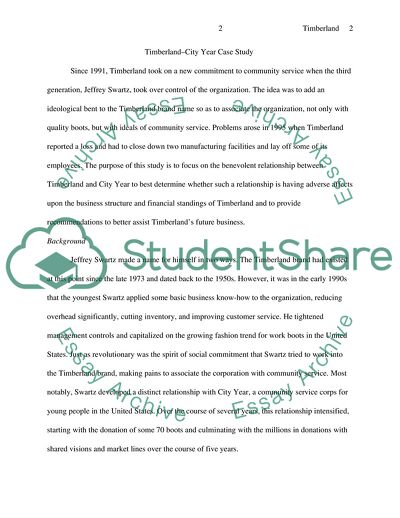
- Home
- Free Samples
- Premium Essays
- Editing Services
- Extra Tools
- Essay Writing Help
- About Us
- Studentshare
- Subjects
- Miscellaneous
- Case Study; Organizational recomendation and implementation plan
Case Study; Organizational recomendation and implementation plan - Essay Example

- Subject: Miscellaneous
- Type: Essay
- Level: Undergraduate
- Pages: 4 (1000 words)
- Downloads: 0
- Author: igreenholt
Extract of sample "Case Study; Organizational recomendation and implementation plan"
y Year to best determine whether such a relationship is having adverse affects upon the business structure and financial standings of Timberland and to provide recommendations to better assist Timberland’s future business. Jeffrey Swartz made a name for himself in two ways. The Timberland brand had existed at this point since the late 1973 and dated back to the 1950s. However, it was in the early 1990s that the youngest Swartz applied some basic business know-how to the organization, reducing overhead significantly, cutting inventory, and improving customer service.
He tightened management controls and capitalized on the growing fashion trend for work boots in the United States. Just as revolutionary was the spirit of social commitment that Swartz tried to work into the Timberland brand, making pains to associate the corporation with community service. Most notably, Swartz developed a distinct relationship with City Year, a community service corps for young people in the United States. Over the course of several years, this relationship intensified, starting with the donation of some 70 boots and culminating with the millions in donations with shared visions and market lines over the course of five years.
Timberland’s practice of modern day philanthropy, although good hearted, cannot go without both challenges and criticisms. Although the partnership generated great benefits to society and the two organizations, there are still weaknesses in the collaboration. Differences in agendas between a for-profit company and a non-profit organization were sometimes acute. However, the most drastic problems surfaced in late 1994, early 1995. The loss for Timberland was financial, leading many employees worrying about an uncertain future of the organization.
Timberland was forced to scale back its operation, laying off a number of employees and outsourcing labor. City Year also faced funding problems, as Congress threatened some of its primary funding sources. Community
...Download file to see next pages Read MoreCHECK THESE SAMPLES OF Case Study; Organizational recomendation and implementation plan
Organisational Change at True Value Processing Plant
Recommendations to some of the pertinent HRM problems
PROJECT MANAGEMENT - CASE STUDY
MHC Case Study
Organisational Change Management: Human Resource Management, Organisational Behaviour and Tourism
Position of Nucor Corporation, a Leading Producer of Steel in the US Market
Organizational Management Change - European Electricity Company
Approaches to Organizational Leadership Change

- TERMS & CONDITIONS
- PRIVACY POLICY
- COOKIES POLICY